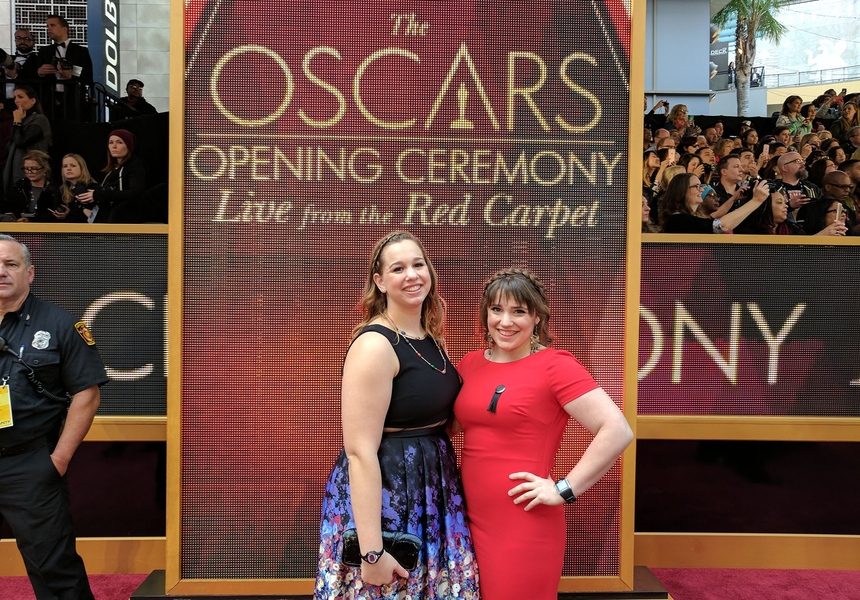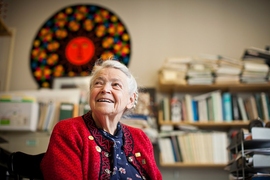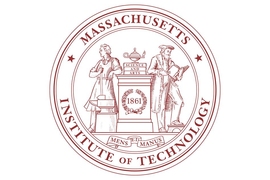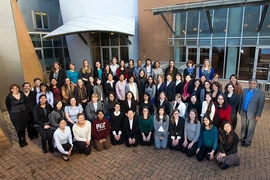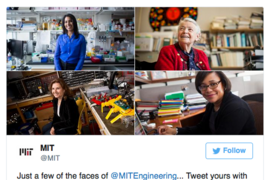When Institute Professor Emerita Mildred Dresselhaus passed away on Feb. 20, MIT and the national science community lost a leader, not only in terms of her remarkable personal achievements as a nanoscience pioneer, but also her considerable effort to encourage women to seek careers in science. Dresselhaus’ achievements have inspired a great many women to follow in her footsteps — including her granddaughter, Leora Cooper, who is currently pursuing her PhD in physical chemistry with Professor Keith Nelson at MIT.
As part of a campaign to promote women’s careers in science, GE recently released a video that asks, “What if Millie Dresselhaus, female scientist, was treated like a celebrity?” In the spot, little girls play with Dresselhaus dolls and dress up in her signature braids and sweaters, parents name their daughters after her, and Dresselhaus gives celebrity interviews. As part of this campaign, GE also invited Dresselhaus to walk the red carpet at the Academy Awards in Los Angeles. Following Dresselhaus’ death, it was decided that Cooper and her cousin, Clara Dresselhaus, would attend the Academy Awards in the late Institute Professor emerita's place, representing both their grandmother and future generations of female scientists.
Q: How did growing up with one of the great female celebrities in science as a role model affect you, and what advice can you impart upon young girls who aspire to follow in your and your grandmother’s footsteps by seeking careers in STEM fields?
A: Math and science have been an important part of my life for as long as I can remember. Millie was always very modest and never wanted to impose her ideas on anyone, but science was such a large part of her life that it spilled into everything else she did. As young girls, my sister and I went on science adventures together with our mother or grandmother. We were always encouraged to be curious about our surroundings and to try to learn how things worked. The highlight of many days were my morning rides to school where my father explained how something in science or engineering worked. In family and in mentoring, Millie always led by example. I’m certain that she inspired the family spirit that science holds answers to the world around us. It wasn’t until later in my life that I started to understand that other young girls got very different childhood messages.
As I have progressed through college and now graduate school, I see inequalities that I didn’t notice as a child. I see minorities having difficulty receiving the opportunities they deserve, I see honest immigrants being turned away at the border, and I have watched women get discouraged from pursuing careers in all walks of life. I came to understand that Millie’s success story was an anomaly and not the norm. As I started struggling with many of these same issues, I started speaking with her about how changes should be made, but I always assumed that change would need to come from others. During her career, Millie gave talks in at least 30 countries, and she had advisory capacities in numerous universities, foundations, and even government agencies across the world. By example, she showed me that a career in STEM can give a voice to the issues that surround us. In my years with Millie at MIT, we began talking about ideas for changes that could help women to succeed, but in our last year together she showed me how to stand up and start seeing those ideas through to reality. She has shown me that a STEM career can give you a voice to see these changes become a reality.
My cousin, Clara, is the next generation. She is thinking of going into STEM now, and will have to be strong enough to get through these same issues that generations before her have contend with. Her grandmother gave her a wonderful role model, but not a guide as she begins to face these difficulties. Like other women in STEM, she will need to build her own support group to get the support and mentorship she needs to continue. But if scientists in our generation follow Millie’s example and push, we can make this easier in future.
For young girls, my advice is to keep asking questions, even if you need to work to find the answers. Don’t ever let yourself say “I must not be good at this”; instead, ask yourself, “what did I miss here?” But from Millie, I have learned that inspiring young girls to pursue STEM is only the first hurdle. The advice should never stop. We all benefit from having a base of people to advise us and help us continue to achieve our dreams. My advice to women, from young girls to established women, is to stand up when you see something that isn’t right, and start working to make these changes happen in the world around us.
Q: What does appearing on the Academy Awards’ red carpet in your grandmother’s stead mean to you?
A: This experience honors Millie in more ways than you would expect. As a poor girl growing up in the Bronx, Millie didn’t have the money she needed to see the movies like her friends. To join them, she took a job reviewing movies for a local newspaper, which gave her free tickets. Millie always said that this job first taught her how to write clearly and succinctly. Even at the end of her life, she wrote papers longhand on her lap, as she learned from those days.
For my part, I have seen the red carpet at the Academy Awards as a mythical place that just wasn’t for people like me. I always saw the society and science as versions of “cool” that rarely overlapped. Going into science has isolated me a lot from pop culture, but getting to bring the two together is a special opportunity. As a high school student, Clara Dresselhaus has watched more movies and followed the actors more than I have. Her connection to popular culture gives her a better understanding of how the younger generation responds to science and technology and how to get them excited by it. Clara and I can make a team that understands how to bring the important issues in science and pop culture together, just as Millie always encouraged in scientific collaborations across fields.
When GE first gave Millie the script for the Real Heroes commercial, she was extremely hesitant to let it take her away from her students, as she didn’t understand the point. She showed it to me and asked what I thought she should do. The script described scenes that painted a picture of her as a modern celebrity because of her scientific achievements, inspiring even young girls who couldn’t yet understand her contributions. With the help of her assistant, Read Schusky, I explained to her that being part of the commercial would allow her to inspire a new demographic that can be hard to reach as scientists. The commercial aired shortly before her death, and Millie never got a chance to see the impact that it will make.
GE’s invitation to attend the Academy Awards on her behalf is almost the very definition of bittersweet. Millie’s invitation gives me hope that society is learning how to value female scientists for their achievements and contributions. Millie always loved having interdisciplinary projects bring seemingly unrelated fields together. I wish she could have laughed and enjoyed seeing science and entertainment come together in this wonderful way. Millie always knew when her students needed a little push to be able to achieve something new. In walking the red carpet, I see Millie giving me that push she knew I needed to learn how to reach out to the women of the next generation. For me, the red carpet represents both the loss of my grandmother and mentor, and the opportunity to continue her legacy of encouraging society to value science.
Q: What positive impact will the Hollywood representation of female pioneers in science like your grandmother and the women whose stories are featured in the Oscar-nominated film “Hidden Figures” have on the future of women in STEM fields?
A: Science and Hollywood both spread new information to wide groups of people across the world, but they access different venues. While films reach a general demographic, science is still widely viewed as unintelligible. At MIT, most of us are familiar with trying to explain our work to a non-technical person only to have them respond, “don’t bother, I won’t understand it.” Even the most general of science talks and events have trouble reaching these non-technical people. Hollywood gives science a voice that can be heard by the non-technical. This allows people from non-technical parts of the world to see a life that they do not know or understand.
Without being accustomed to the struggles female scientists often face, non-technical people who see films like “Hidden Figures” can see injustices they weren’t aware of. This allows us to celebrate people who have overcome these injustices in much the way that Millie and the stars of “Hidden Figures” have at MIT and NASA respectively. These are often injustices that go unnoticed by people within STEM because the ubiquity of it causes us to become accustomed to it. Women’s suffrage and the civil rights movements have shown us that society better addresses issues that have a common voice. The Hollywood representation of female scientists as underrepresented heroes can help the world recognize the importance of encouraging women in STEM.
